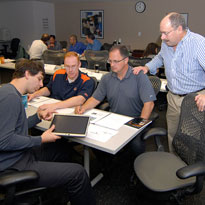Positioning & Location
- Course:Positioning & Location
- Course ID:POSLOC Duration:3 days Where: Your Office (7+ Persons)
- Download Course Description (PDF)
Available as a private, customized course for your group at your offices or ours and in some cases as a WebLive(TM) class.
Course Outline
Part 1: Introduction to Positioning
- Radio Access Operations
- Handset to Base Station
- GSM vs. CDMA
- Mobility Management
- Roaming
- Databases
- Network Elements
- Network Signaling
- SS7 vs. IP
- SS7 Trunk Signaling
- SS7 Database Signaling
- Network Elements
- Review of GSM Network
- History of Mobile Positioning
- FCC Order for Phase 0, 1, and 2
- Carrier Decisions to Comply
- Evolution of GPS Deployment and Usage
- History and Direction of LBS Applications
- Location-based Applications
- Location-enabled Applications
- Location Is Part of Everything
Part 2: Overview of Cellular Positioning Methods
- Cell Site Location
- Gross-level Location
- Cell Site vs. other Methods
- Terrestrial Methods
- Time Division of Arrival (TDOA)
- Angle of Arrival (AOA)
- Pattern Matching and others
- Satellite Methods
- Autonomous GPS
- Assisted GPS
- Non-cellular Methods
- RFID
- WiFi
- WiMAX
- Bluetooth
- Others
- Discussion of Advantages and Disadvantages
- Handset vs. Network Issues
- Accuracy Issues
- Fitness for Use
Part 3: Geographic Information Systems (GIS)
- Data Representation
- Vector
- Rastor
- Provisioning and Administration
- Geo-coding
- GIS Systems Overview
- Administration and Management
- GIS Data Processing of Location
- Point in Polygon
- Radius Search
- Other Methods
- GIS Solutions and Providers
- NAVTEQ
- Others
Part 4: Location Management
- Different Architectures
- User Plane
- Control Plane
- Standardized Architectures
- CDMA vs. GSM
- Standard GSM Architecture
- Protocols and Procedures
- Location Management Issues
- Pull vs. Push Location
- Trusted vs. Non-trusted
- Quality of Service (QoS)
- Location Gateway Function
Part 5: Location-based Applications
- Different Types of Applications
- Voice vs. Non-voice Applications
- Commercial vs. Non-commercial Services
- Wireless E 9-1-1 (E911)
- J-STD-36
- Call Flows
- Commercial Control Plane Applications
- Application Discussion
- Network Elements
- Messaging and Call Flows
- Commercial User Plane Applications
- Application Discussion
- Network Elements
- Messaging and Call Flows
Part 6: LBS Application Challenges
- Privacy and Security
- Commercial Issues: Google and your Carrier Knows your Location !
- Legal and Regulatory: Laws and Industry Rules
- Law Enforcement and Other Special Cases: Lawful Intercept and Location
- Working with Operators and Third-party Companies
- Mediation and Brokering
- Service Level Agreements (SLA)
- Activation and Provisioning
- Billing and Settlement
- Application Integration
- Two or More Applications
- Integration with Non-LBS Systems
Part 7: Workshop: Designing an LBS Application/System*
- Application Design
- Commercial vs. Non-commercial
- Unique Requirements for Application
- System Design
- Positioning Requirements
- Location Management Requirements
- GIS Requirements
- Other Requirements
* Instructor-provided choices of applications are provided
Part 8: Positioning and LBS Ecosystem
- Ecosystem and Value-chain
- Ecosystem Review
- Value Chain in Service Delivery
- Hot and Emerging Areas
- Location Brokering/Mediation
- Advertising/Marketing
- Social Networking
- Personal Safety
- Discussion of Major Players
- Wireless Carriers
- Positioning System Providers
- Service Bureau Companies
- Application Companies
- Content Companies
Part 9: Introduction to Advanced Topics
- Advanced Topics
- Presence vs. Location
- Next Generation Networks (NGN)
- NGN Applications: 9-1-1, Personal Safety and More
- Context Aware NGN
Part 10: The Future of LBS
- Latest FCC Order
- New Accuracy Requirements
- Implications for Industry
- Trusted-party Mediation
- Automatic Opt-in and Trusted Location
- Implications for Uses and Providers
- Everything Is Geo-coded
- Google and others are Geo-coding the World
- Implications for Society
- Location and Social
- Manual “Check-in” goes Autonomous
- Location Monetizes Social
- User Generated LBS Content
- Virtual “Post-it Notes”
- Social Networking, Gaming, Commerce, and More
- LBS and Augmented Reality
- Taking Notes and Geo-coding to a Whole New Level
- Implications for Industry and Society
- End-user Services Customization
- Location-enabling your Personal World
Part 11 – Workshop: Designing Your Own Application*
- Type of Application and Assumptions
- Voice, Non-voice, or Both
- Application Goals
- Determine Use Cases
- How Shall Users Use the System?
- Determine Positioning Systems
- Determine Location Management Systems
- Identify Messaging and/or Call Flows
- Identify Potential Regulatory and Business Issues
- Wrap-up
- Course recap
- Discussion
- Participant evaluation of the course
* Participants design their own system and applications from the ground up
Course in a Nutshell
There is no other attribute that better defines mobile communications than mobility and no better asset than location. Effectively leveraging this asset is based on the ability to determine the position of the target mobile device, obtain the position data from cellular network, and resolve the data into useful and context specific location information.
This course will equip you with the basics of mobile positioning and location management as well as a firm understanding of positioning systems, location management infrastructure, standards, technologies, Location Based Service (LBS) applications, and various vendor solutions. You will learn about the relationship of positioning technologies to network infrastructure and geographic information systems. The session includes a workshop involving network planning and LBS application design.
Customize It!
This course can be extended or shortened as required. It can also be revised to cover the positioning and location methods or applications of particular interest to your group.
Aimed At
This course is aimed at those interested in the commercial, homeland security, or national defense application of positioning and location technologies.
Prerequisites
Background in the underlying telecommunications technologies.

